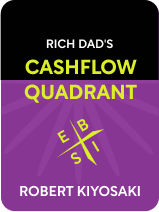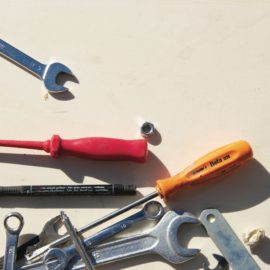

This article is an excerpt from the Shortform book guide to "Rich Dad's Cashflow Quadrant" by Robert T. Kiyosaki. Shortform has the world's best summaries and analyses of books you should be reading.
Like this article? Sign up for a free trial here .
What do self-made millionaires have in common? What is their secret to building wealth?
Most people believe that the key to wealth is getting a “good,” high-paying job. But according to Robert Kiyosaki, wealth generation requires a different skillset and mindset.
Learn about the mindset and the soft skills central to wealth building, according to Kiyosaki.
Robert Kiyosaki on Wealth Building
According to Kiyosaki, the type of income you generate is more important than the type of work you do. He divides income into four categories, which he calls “cashflow quadrants”:
- Employees (E)
- The self-employed and small business owners (S)
- Big business owners (B)
- Investors (I)
According to Kiyosaki, the first two income categories, employees (E) and the self-employed and small business owners (S), are usually dead-ends on the road to wealth. The other two categories, big business owners (B) and investors (I), are the most conducive to building wealth because those are the categories in which you can develop passive income in the form of assets.
Kiyosaki says that while lower-, middle-, and even upper-middle-class parents teach their kids the out-of-date financial path we just outlined, rich parents teach their kids the income generation strategy of the Business owner (B) and Investor (I) categories.
According to Robert Kiyosaki, wealth generation in the B and I categories requires a different kind of mindset and skillset. Here we’ll focus on the soft skills central to wealth building and explain why Kiyosaki says a good relationship to money, risk, and yourself is key to being able to generate wealth.
1. Become Financially Literate
Ours is a world run by people who understand how money works. If you don’t, you’re vulnerable. People who understand how money works get their income from the B and I categories because they know it’s the best choice for generating wealth. If you’re aiming to make your living in the B and I categories, it’s imperative to be fluent in money. Remember, you need to actively take charge of acquiring a financial education because it’s likely that your parents and education didn’t adequately prepare you.
1. Learn by doing, and by failing. Kiyosaki says the best way to learn in the B and I categories is by actually doing some business and investing. Making mistakes is an integral part of the learning process. When you make a mistake and then work to understand why it was a mistake, you’re doing some of the best learning.
(Shortform note: In business, learning on the fly never stops, because you have to adapt as the business environment changes in ways you may not ever be able to predict.)
2. If it makes sense for you, continue in your formal education. Go to classes and seminars about topics that interest you. If you’re academically inclined, get a degree in a B and I field.
(Shortform note: But remember that an MBA may not be worth the money, especially in a post-Covid world.)
3. Talk to people who do what you want to do or have information about your field. Do your own research. Read business news and newsletters. You need to understand the current market and legal environment you’ll be working in.
(Shortform note: When Kiyosaki wrote Rich Dad’s Cashflow Quadrant, the internet was nowhere near as ubiquitous as it is now. Email newsletters can be a great way to learn about investing or a particular industry. They can also help you cut through the seemingly endless advice on the internet.)
4. Learn history, especially economic history, because history repeats itself. By having some knowledge of history, you’ll be able to put the current moment in context.
(Shortform note: Many academics, business leaders, and government financial officials agree that both undergraduates and graduates need more training in economic history. They emphasize that students need to understand the frequency and magnitude of economic disturbances in the past, so they’re adequately prepared for their possibility in the future.)
Learn to Love Learning
Many people who excel in business, and many other fields, were poor students in their traditional education. According to Kiyosaki, school creates an environment where students are afraid to fail and failure is punished. “A” students never failed in school, and so they become adults who are afraid to experience failure. “C” students already got over the shock of not being the best every time. For that reason, they’re more willing to take risks, which is key to success in the B and I categories.
(Shortform note: While there isn’t research to back up this business legend, other commentators add that “C” students are less likely to be perfectionists, which benefits them in business, where nothing ever goes perfectly. They also note that “C” students may have had lackluster grades because they devoted time to developing passions outside of school, which shows curiosity and determination. At the same time, Kiyosaki specifically notes that getting an MBA from an elite institution is a good way to break into the B category. “A” students are more likely to find their way to a top-tier business school.)
Many skills important in business and money-making (and life in general) aren’t taught in school and are often more important than an A in advanced English or trigonometry.
Kiyosaki emphasizes that we need to learn to love learning, but that some of the most important learning happens outside of traditional education. It’s vital to figure out what you want to learn about, and how you want to learn about it. It may look nothing like sitting in a classroom.
(Shortform note: Kiyosaki name-checks Daniel Goleman’s book Emotional Intelligence. Goleman argues that success in life is determined only 20% by IQ and 80% by other factors. Emotional intelligence, which he defines as the ability to understand and govern your emotions, counts for part of that other 80% and is an important business skill.)
2. Get Over Your Fear of Money
Before you can make any change to your financial situation, Kiyosaki emphasizes that you need to have a healthy relationship with money. Kiyosaki says fear of money—fear that you don’t understand it, fear that you won’t have enough, fear of taking financial risks, or a thousand other worries related to money—makes sense. Money is core to survival, impacts virtually every part of our lives, and is the difference between freedom and freefall.
But Kiyosaki says fear of money impairs our journey in two ways:
- Fear of money can cause us not to act at all. Kiyosaki says this is a particular issue for people transitioning from the E and S, who are used to the academic method of gathering as much information as possible before making a decision. This doesn’t work in the B and I categories, Kiyosaki says, because learning by doing is so important.
- Fear of money causes us to make decisions based on emotion, not logic. Emotion-based decisions are rarely the best, or even good, financial decisions.
3. Take Action, One Step at a Time
Learning to succeed in the B and I categories is a long process. But you’ll never learn, and never succeed, if you don’t try. In fact, Kiyosaki says on-the-job experience and especially mistakes are the best learning.
- Take baby steps. Move incrementally and build your wealth as you build your skills. Don’t bite off more than you can chew—you could lose it all.
- You’ll get positive reinforcement when you complete a small step.
- Avoid paralysis by analysis. If you don’t even try, you’ll never ever begin to see benefits. You can’t have all the answers or full confidence before you start, because you need to learn by doing. No one has all the answers or full confidence all the time.
- This is a symptom of our no-mistakes-allowed education system and afflicts people with more education.
- Think long term, don’t expect immediate results, and let the magic of compounding systems or money do its work. Know it’s a long game.
| Break It Down Kiyosaki emphasizes that the journey to financial security and freedom is a marathon, not a sprint. James Clear’s concept of “atomic habits” from his book by the same name is useful for breaking down a big undertaking into smaller parts. Atomic habits are small (atom-sized) adjustments that are easier to start and will eventually compound into changed behavior. Clear identifies three types of motivation that create different habits, which can all be useful when working up to big financial changes. Outcome-driven habits form around a goal. While it’s crucial to set a goal, whether it be financial security, financial independence, or financial freedom, just working toward one large goal doesn’t necessarily integrate it into your everyday behaviors, or your sense of self. Process-based habits form around a system. Thinking about your habits as a network of actions that are inherently a part of the goal elevates the work and makes you more likely to stick with it. Instead of narrowly focusing on financial independence and how much you have left to earn and save before you achieve it, you could try to consider financial research, networking, and managing your investments as a core part of the process. Identity-based habits form around your self-conception. Combined with process-based habits, this is perhaps the most effective kind of habit because it taps into your sense of self. You’re most likely to stick with habits like reading investment newsletters and taking on increasing amounts of managed risk if you decide those activities are part of who you are. |
4. Believe in Yourself
Kiyosaki puts equal emphasis on cultivating the emotional constitution to succeed in the B and I categories; on feeling like a B/I category earner.
1. Attitude and affirmations matter. If you think you’ll be poor, you’re more likely to be. Set yourself up for success by expecting to be successful in the long run. At the same time, expect disappointment. If you’re not making a mistake or failing at least once and a while (and probably a lot more), you’re probably not taking enough action or enough risk.
(Shortform note: In The Power of Positive Thinking, Norman Vincent Peale says you need to cultivate belief in the face of a difficult undertaking, even if you have doubt. To cultivate belief, he says you need to genuinely want what you’re trying to accomplish, have a clear goal, and visualize the best outcome, not just a good one.)
2. Have determination. Succeeding in the B and I categories is a marathon, not a sprint. Your ability to succeed depends on your ability to respond to challenges without being knocked off your path. At the same time, cut yourself some slack and practice self-care. Because it is a marathon and not a sprint, you won’t make it to the finish line if you’re completely worn out.
(Shortform note: In her book Grit, Angela Duckworth argues that between two people with equal ability, the grittier person will achieve more success, and that grit is a skill that can be honed with practice.)

———End of Preview———
Like what you just read? Read the rest of the world's best book summary and analysis of Robert T. Kiyosaki's "Rich Dad's Cashflow Quadrant" at Shortform .
Here's what you'll find in our full Rich Dad's Cashflow Quadrant summary :
- Why the traditional path of college to career doesn't work
- Which types of income will lead you to financial freedom
- An in-depth look at Robert Kiyosaki's four cashflow quadrants







I am an south african citizen and i am 22 years old. Its a struggle for me to be able to start at a point because i too want to be part of the giants.